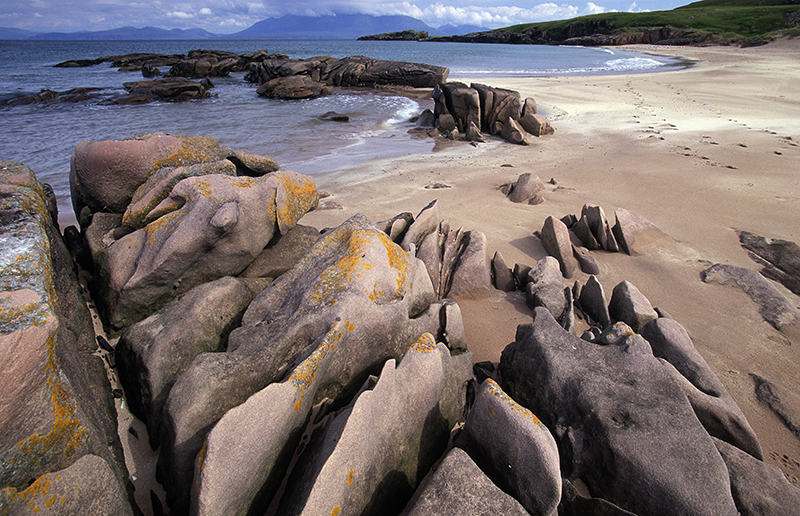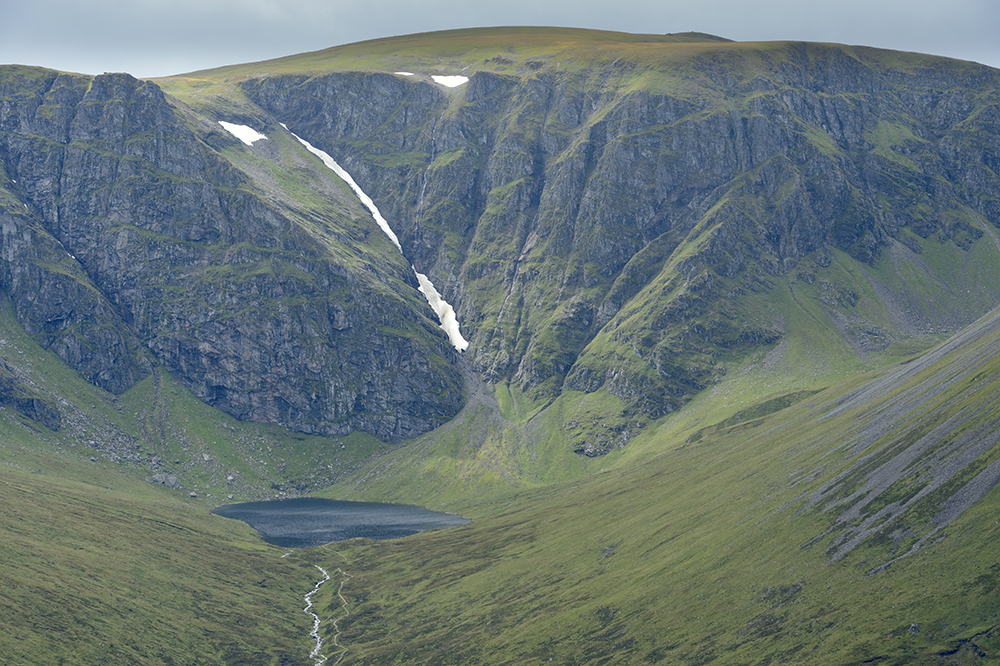Scotland’s rocks and landforms provide a range of benefits and help us to understand how the Earth has evolved. They provide us with valuable economic resources and naturally regulate hazards and flooding.
Key messages
- Scotland’s rocks and landforms (geology and geomorphology), created by natural processes over the last 3 billion years, are of national and international importance for demonstrating key geological processes and events in the Earth’s history.
Siccar Point on the South-East coast of Scotland is world-renowned in geological science, famous for outcrops that reveal 'Hutton's Unconformity', and is a location rightly regarded by many as the birthplace of modern geology.
YouTube: Siccar Point – the birthplace of modern geology – British Geological Survey
- Rocks and landforms are part of Scotland’s rich geodiversity – the variety of rocks, minerals, fossils, landforms, sediments and soils, and the natural processes that form and alter them.
-
Rocks and landforms in Rum – © Laurie Campbell, – NatureScot
- Scotland is made up of a wide variety of rocks and sediments of different ages including:
- some of the oldest rocks in the world (hard rocks deformed by heat and pressure deep inside the Earth over 3 billion years ago)
- Rocks formed from sediments (such as sand and mud) and by volcanic activity throughout geological time
- deposits left by glaciers a few thousand years ago
- river, lake and coastal sediments, some still accumulating today
These rocks contain;
-
- fossils, some of which are internationally important
- economic resources, such as aggregates and crushed rock, coal, oil and metal ores including rare and precious minerals
- Scotland’s landforms have been shaped over time by:
-
- Ice
- Waves
- Water
- wind
- landslides.
- The advance and retreat of glaciers have created many of the landforms we see today, such as:
- Mountain corries
- deep lochs
- crag-and-tail hills on which Edinburgh and Stirling Castles sit.
- Our varied coastline was formed by many processes, including sea-level changes caused by the last ice age. Today, we have the highest cliffs and some of the largest sand dunes in the UK, as well as important mudflats and salt marshes.
- There are many different river features formed by a range of river types, from steep mountain torrents to meandering channels in the lowlands.
Creag Meagaidh - © Copyright Lorne Gill - NatureScot
- Our geodiversity is the foundation of our biodiversity, scenery, and cultural heritage and naturally regulates hazards such as flooding.
- Understanding how rocks and landforms change over time will help us understand and adapt to current issues, such as climate change and rising sea levels. Mismanagement of our rocks and landforms could reduce our ability to adapt to the impacts of climate change.
- Scotland has a long history of minor earthquakes, with magnitudes mostly below 4 on the Richter local magnitude scale. Landslides most often occur on steep slopes. Many recent landslides in Scotland have been initiated during prolonged or extreme rainfall, and a number have caused disruption to transport routes.
Rocks and the environment
The rocks beneath our feet affect the environment in many ways.
- Groundwater availability and quality is strongly dependent on rock type. Some rocks, such as fractured or permeable rocks, are more likely to provide pathways for pollutants, such as nitrate, to travel into groundwater.
- Flood risk in a catchment is not only dependent on slope, land use and vegetation, but also on the permeability of the soils, rocks and sediments in the catchment.
- The rocks beneath our feet offer opportunities for renewable energy, in particular heating our homes and buildings, through geothermal energy. Ground source heat pumps and mine water offer heating opportunities but also carry risks of pollution.
- Some rock types are naturally radioactive and produce radon. The UK Health Security Agency has published reports containing maps of radon affected areas for the UK.
Data
Subsurface data
The British Geological Survey (BGS) is the UK's premier provider of objective and authoritative geoscientific data, information and knowledge to help society to use its natural resources responsibly, manage environmental change and be resilient to environmental hazards. It provides impartial and independent geoscientific advice to governments, local authorities, companies and people.
BGS data can be viewed and accessed in different ways.
The Open Geoscience Portal provides general geoscientific information
- view basic geology data through the BGS Geology Viewer for desktop or mobile device
- search and download photos from the GeoScenic geological photo archive.
BGS GeoIndex (Onshore)
- The BGS GeoIndex (onshore) is a professional web-based mapviewer for desktop or mobile device, which holds a wide range of geological map data, including
- 1:50,000 scale geology map data, separated in bedrock, superficial, artificial (man-made) and mass-movement (landslide) deposits
- Borehole records, including drill cores and water wells
- Landslides
- Earthquake data and seismic hazard maps
- and much more.
Specific enquiries (for Scotland) can be directed to BGS Edinburgh Enquiry Service, email: enquiry@bgs.ac.uk.
Location-specific BGS reports can be provided for specific purposes, such as radon risk, subsidence, or borehole prognosis for water boreholes or ground source heat pump boreholes.
Geodiversity: Protected nature sites
The results of NatureScot's site condition monitoring programme can now be searched live through the Protected Nature Sites data analysis application. Here you can find the number of Earth science features that have been assessed as favourable, unfavourable or recovering due to management, as well as searching by area, or using more detailed selection tools to find how many Earth science features have a record of irreversible damage (‘partially destroyed’) at their last assessment. Data on pressures impacting features can also be searched.
What are we doing?
Statutory protection and monitoring. There are around 895 nationally and internationally important rock and landform sites in Scotland (identified by the Geological Conservation Review (GCR)). Around 75 % of these are protected as notified Earth science features in Sites of Special Scientific Interest (SSSI), and their condition is monitored under NatureScot's Site condition Monitoring programme. Monitoring results are available through the Protected Nature Sites data analysis application.
Scottish Geology Trust. Founded as a charitable organisation in 2020, the Scottish Geology Trust aims to inspire people everywhere to understand, love and care for Scotland's incredible geological heritage and its role creating a sustainable future. Projects include: 51 Best Places to see Scotland's Geology, Geology does ... and Scotland's geosites.
Local Geoconservation. Local groups work with local authorities to designate Local Geodiversity Sites and work to raise awareness of sites and geodiversity through publicity such as leaflets, booklets, posters, interpretation boards and websites, and by developing access and educational usage of sites and trails.
Scotland's Geoparks. Celebrate our outstanding geological heritage and its links to culture, education and sustainable economic development.
Policy and legislation
Sites of Special Scientific Interest (SSSI) are the principal method for protecting nationally and internationally important rock and landform (geology and geomorphology) sites in Scotland. Important 'GCR' sites, identified by the Geological Conservation Review are notified as protected Earth Science interest features in SSSIs, which is a statutory designation made by NatureScot under the Nature Conservation (Scotland) Act 2004. Under Section 19 (1) of this Act any person (whether owner, public body or third party) who intentionally or recklessly damages any notified feature of and SSSI, may be guilty of an offence. Where damage to an SSSI is an offence, including damage to Earth science (rock and landform) features, Police Scotland class the offence as a wildlife crime.
Local Geodiversity sites (LGS) are part of the Local Nature Conservation Sites (LNCS) system in Scotland. LGS, which are selected by Local Authorities, are the most important places for rocks and landform outside statutorily protected Sites of Special Scientific Interest (SSSI). Many, but not all Local Authority areas in Scotland now have Local Geodiversity Sites, which are listed in the Local Development Plan. Local Authorities may also develop Local Geodiversity Action Plans, sometimes as part of their Local Biodiversity Action Plan, and most commonly centred around LGS.
Geoparks, national parks and national nature reserves also help protect rocks and landforms and marine protected areas (MPAs) help protect seabed features.
National Planning Framework 4 - Policy 4 (Natural Places) gives SSSIs, NNRs, National Park and LNCS (including Local Geodiversity Sites) protection in the planning system. Developments affecting an SSSI, National Park or NNR will only be supported where site integrity will not be compromised, or adverse effects are outweighed by social, environmental or economic benefits of national importance. Developments affecting an LNCS will only be supported where they will not have significant adverse effects on site integrity, or adverse effects are clearly outweighed by social, environmental, or economic benefits of at least local importance.
National Planning Framework 4 - Policy 33 (Minerals) supports the sustainable management of mineral resources and minimising the impacts of extraction of minerals on communities and the environment.
Scotland's Geodiversity Charter encourages everyone to work together to raise awareness of, and manage, Scotland’s geodiversity; and to ensure its better integration into policy and guidance to meet Scotland’s economic, social, cultural and environmental needs.
Scottish Fossil Code aims to help protect Scotland's fossils while encouraging public interest and responsible use.
Scottish Core Code (2011) combats the growing problem of core holes defacing rock outcrops, provides guidance on responsible and environmentally acceptable rock coring.
This page was updated on 29 Jun 2023
Adobe Acrobat Reader is the free, trusted leader for reliably viewing, annotating and signing PDFs.
Download Adobe Acrobat Reader


